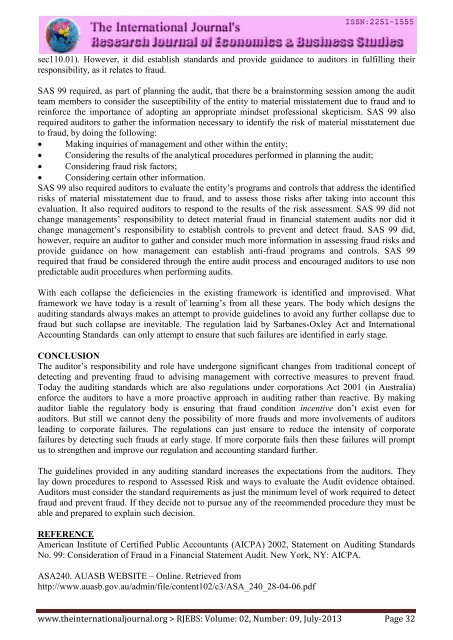Research Journal of Economics & Business Studies - RJEBS - The ...
Research Journal of Economics & Business Studies - RJEBS - The ...
Research Journal of Economics & Business Studies - RJEBS - The ...
Create successful ePaper yourself
Turn your PDF publications into a flip-book with our unique Google optimized e-Paper software.
sec110.01). However, it did establish standards and provide guidance to auditors in fulfilling their<br />
responsibility, as it relates to fraud.<br />
SAS 99 required, as part <strong>of</strong> planning the audit, that there be a brainstorming session among the audit<br />
team members to consider the susceptibility <strong>of</strong> the entity to material misstatement due to fraud and to<br />
reinforce the importance <strong>of</strong> adopting an appropriate mindset pr<strong>of</strong>essional skepticism. SAS 99 also<br />
required auditors to gather the information necessary to identify the risk <strong>of</strong> material misstatement due<br />
to fraud, by doing the following:<br />
Making inquiries <strong>of</strong> management and other within the entity;<br />
Considering the results <strong>of</strong> the analytical procedures performed in planning the audit;<br />
Considering fraud risk factors;<br />
Considering certain other information.<br />
SAS 99 also required auditors to evaluate the entity’s programs and controls that address the identified<br />
risks <strong>of</strong> material misstatement due to fraud, and to assess those risks after taking into account this<br />
evaluation. It also required auditors to respond to the results <strong>of</strong> the risk assessment. SAS 99 did not<br />
change managements’ responsibility to detect material fraud in financial statement audits nor did it<br />
change management’s responsibility to establish controls to prevent and detect fraud. SAS 99 did,<br />
however, require an auditor to gather and consider much more information in assessing fraud risks and<br />
provide guidance on how management can establish anti-fraud programs and controls. SAS 99<br />
required that fraud be considered through the entire audit process and encouraged auditors to use non<br />
predictable audit procedures when performing audits.<br />
With each collapse the deficiencies in the existing framework is identified and improvised. What<br />
framework we have today is a result <strong>of</strong> learning’s from all these years. <strong>The</strong> body which designs the<br />
auditing standards always makes an attempt to provide guidelines to avoid any further collapse due to<br />
fraud but such collapse are inevitable. <strong>The</strong> regulation laid by Sarbanes-Oxley Act and International<br />
Accounting Standards can only attempt to ensure that such failures are identified in early stage.<br />
CONCLUSION<br />
<strong>The</strong> auditor’s responsibility and role have undergone significant changes from traditional concept <strong>of</strong><br />
detecting and preventing fraud to advising management with corrective measures to prevent fraud.<br />
Today the auditing standards which are also regulations under corporations Act 2001 (in Australia)<br />
enforce the auditors to have a more proactive approach in auditing rather than reactive. By making<br />
auditor liable the regulatory body is ensuring that fraud condition incentive don’t exist even for<br />
auditors. But still we cannot deny the possibility <strong>of</strong> more frauds and more involvements <strong>of</strong> auditors<br />
leading to corporate failures. <strong>The</strong> regulations can just ensure to reduce the intensity <strong>of</strong> corporate<br />
failures by detecting such frauds at early stage. If more corporate fails then these failures will prompt<br />
us to strengthen and improve our regulation and accounting standard further.<br />
<strong>The</strong> guidelines provided in any auditing standard increases the expectations from the auditors. <strong>The</strong>y<br />
lay down procedures to respond to Assessed Risk and ways to evaluate the Audit evidence obtained.<br />
Auditors must consider the standard requirements as just the minimum level <strong>of</strong> work required to detect<br />
fraud and prevent fraud. If they decide not to pursue any <strong>of</strong> the recommended procedure they must be<br />
able and prepared to explain such decision.<br />
REFERENCE<br />
American Institute <strong>of</strong> Certified Public Accountants (AICPA) 2002, Statement on Auditing Standards<br />
No. 99: Consideration <strong>of</strong> Fraud in a Financial Statement Audit. New York, NY: AICPA.<br />
ASA240. AUASB WEBSITE – Online. Retrieved from<br />
http://www.auasb.gov.au/admin/file/content102/c3/ASA_240_28-04-06.pdf<br />
www.theinternationaljournal.org > <strong>RJEBS</strong>: Volume: 02, Number: 09, July-2013 Page 32
















